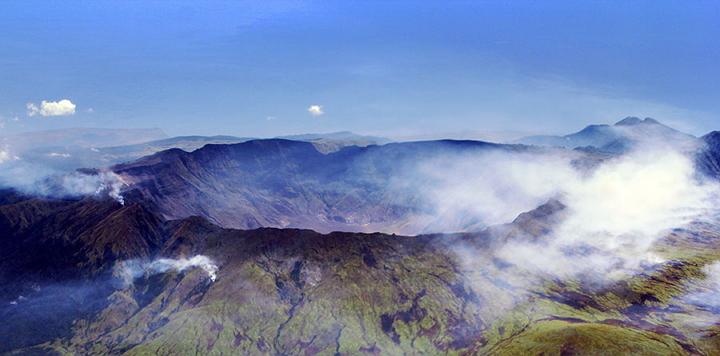
A moderate-sized eruption occurred earlier that month, and it was soon followed by thunderous detonation sounds which were heard nearly 1600 miles away. Lava flows rolled down the mountain to the sea and in the process, wiped out the entire village of Tambora.
The explosion is said to have been a VEI-7 event which released roughly 4 times the energy of the 1883 eruption of Krakatoa, the most famous volcano event outside of the disaster at Mount Vesuvius.
Before the explosion, Mount Tambora was 14,000 feet high and one of the tallest peaks on the Indonesian archipelago. Following the blast, it was reduced to 9,300 feet. It was the single largest observed volcanic eruption in recorded history; ash fell to earth more than 800 miles away from the eruption site, and it remained completely dark in the area up to 400 miles away. Surrounding Indonesian islands were swamped by a tsunami with waves of up to 13 feet high.
Now Dr. Ian Saginor — an Associate Professor of Geology at Keystone College and a geochemist, geochronologist, and volcanologist who has spent the past nine years studying volcanoes throughout Central America and the Caribbean — is seeking funds to 3D print examples of volcanoes for study purposes on GoFundMe.
“My research is on the Geochemical evolution of volcanic arcs, but I also work on designing 3D printed models for various geoscience applications,” Saginor says.
Saginor says the current demand for his models and the information they impart is high, and he’s looking for funding to purchase a high quality 3D printer. He says it will reduce the cost of printing each model by as much as 90%, and that the amount he’s requesting will “fund the printing and delivery of these models for the forseeable future.”
“Models,” he says, “will be provided at no cost to any scientist, educator, or policy maker involved in working to make life near volcanoes as safe as possible.”
These models of volcanoes can be created using 3D printing to allow for precision and the ability to produce them in sufficient quantities to fulfill demand, and all to the same specifications — all at a reasonable cost.
“Hundreds of millions of people worldwide live near active volcanoes and the potential hazards include landslides, mudflows, and tsunamis, not to mention the eruption itself,” Saginor says. ” Protecting the public is as much about low tech solutions such as education and outreach as it is about collecting and analyzing data from the volcano. Hazard maps can show people where the danger is, but a 3D model can show them why.”
Do you think models like this will help officials understand the impact of volcanic events? Let us know in the Volcano Models 3D Printed forum thread on 3DPB.com.